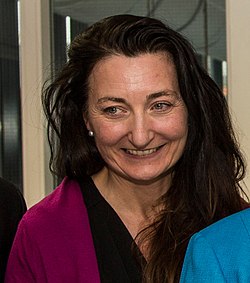Early life and education
May-Britt Moser was born in the small town of Fosnavåg, Møre og Romsdal, Norway, in 1963, the youngest of five children. Although her family owned a small farm, her father worked as a carpenter. This meant that her mother was mainly responsible for caring for the farm. A self-proclaimed "tom-boy," May-Britt was born into a family without excess money, meaning that she did not have the means to travel in the summer. With her free time, she chose to study animals where she found a major passion. May-Britt's mother told her fairytales while she was growing up and always encouraged her to work hard to make her dreams come true. As a child, May-Britt wanted to become a doctor who traveled the world saving people, or even a veterinarian due to her love of animals. She was never a particularly gifted student in grade school, but the right level of encouragement from her teachers saw her talents flourish. Also, her mother - who incidentally herself had nursed a dream of becoming a physician - imposed upon May-Britt that she had to get good grades, lest she have no alternative besides getting a home economics education and end up as a housewife. [6]
Moser attended the University of Oslo where she studied psychology, mathematics, and neurobiology. [5] [7] May-Britt chose this school because two of her sisters lived in the Oslo area and provided her with a temporary place to live. She enjoyed the freedom of university, but was not completely sure what she wanted to do with her degree. She was accepted into dentistry school, but declined the offer. May-Britt soon met Edvard I. Moser, whom she recognized from her high school. [6] The couple married on July 27, 1985, and decided to study the relationship between the brain and behavior. [7] [8] [6] In June 1991, the couple had their first child, Isabel. They found it difficult to balance a PhD program with having a child, but their passion for their studies fueled them to bring their daughter along for long days in the lab. Ailin was born in 1995. [6] Later that year, May-Britt Moser obtained a doctorate in neurophysiology for her work recognizing correlations between the structure of the hippocampus and spatial recognition within rats. [7] May-Britt Moser and her husband traveled briefly to the University of Edinburgh to work with Richard Morris, a neuroscientist. They later visited University College London, where they worked in O' Keefe's laboratory. [7] The couple eventually decided to work at Norwegian University of Science and Technology in Trondheim, where May-Britt became a professor of neuroscience and director of the University's Center for Neural Computation. [5] The couple announced their divorce in 2016, but still continue their scientific work together. [9] [10]
Career
Moser was awarded a degree in psychology at the Department of Psychology at the University of Oslo in 1990. She was then employed as a research fellow at the Faculty of Medicine, where she was awarded her Ph.D. in Neurophysiology in 1995 at the age of 32, [11] under the supervision of professor Per Andersen. She and Edvard Moser went on to undertake postdoctoral training with Richard Morris at the Centre for Neuroscience, University of Edinburgh from 1994 to 1996, and were visiting postdoctoral fellows at the laboratory of John O'Keefe at the University College, London for two months.
The Mosers returned to Norway in 1996 where May-Britt was appointed associate professor in biological psychology at the Department of Psychology at the Norwegian University of Science and Technology (NTNU) in Trondheim. She was promoted to a position as full professor of neuroscience at NTNU in 2000. The couple were instrumental in the establishment of the Centre for the Biology of Memory (CBM) in 2002 and the Institute for Systems Neuroscience at NTNU in 2007. Moser is also head of department of the NTNU Centre for Neural Computation. She also is a member of the Royal Norwegian Society of Sciences and Letters, [12] Norwegian Academy of Science and Letters, [13] the American Philosophical Society, [14] and the Norwegian Academy of Technological Sciences. [15] Moser was appointed by the European Research Council as a member of one of the evaluation panels for ERC startup grants for the period 2007–2009.
The Mosers pioneered research on the brain's mechanism for representing space together with their mentor John O'Keefe. The Mosers discovered types of cells that are important for determining position (spatial representation) close to the hippocampus, an area deep in the brain that is important for encoding of space, and also for episodic memory. Moser investigated correlations between the anatomical structure of the hippocampus and social learning in rats. Moser's work gave the ability for scientists to gain new knowledge into the cognitive processes and spatial deficits associated with human neurological conditions such as Alzheimer's disease.
In 2013, the Trondheim Chamber of Commerce awarded Moser the Madame Beyer award, which recognizes brilliant female business leaders. It was awarded in recognition of Moser's robust leadership, scientific achievements, and her high ethical standards, as well as her consistent focus on teamwork and community spirit. [16]
In 2014, the Mosers shared half of the 2014 Nobel Prize in Physiology or Medicine. The other half of the prize was awarded to John O'Keefe. The Mosers are one of six couples to be awarded a Nobel Prize.
May-Britt Moser was a co-Founder of the Centre for the Biology of Memory, a Research Council of Norway-funded Centre of Excellence from 2003 to 2012, and has taken on the Directorship of the Centre for Neural Computation, a second Centre of Excellence that will run from 2013 to 2022. [17]
This page is based on this
Wikipedia article Text is available under the
CC BY-SA 4.0 license; additional terms may apply.
Images, videos and audio are available under their respective licenses.

